


The TRACE images may be used without restrictions
in publications of any kind. We
appreciate an acknowledgement indicating that
the Transition Region and Coronal Explorer, TRACE,
is a mission of the Stanford-Lockheed Institute for Space
Research, and part of the NASA Small Explorer program. More information on
TRACE and other TRACE images can be found
here.

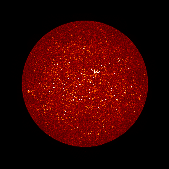 |
With the Sun persisting in a near-minimal state of activity, only
a few small regions of some activity are seen on the disk. Otherwise,
as in this image taken by TRACE in its UV bandpass centered on 1600Å,
on 2008/05/22 just after midnight, only the quiet-Sun network shows up.
The cell-like appearance is formed by the multitude of
small clusters of magnetic flux that are collected in the downflow regions
of the supergranular network of convective motions.
For the full 5120 x 5120 pixel mosaic, click here.
 |
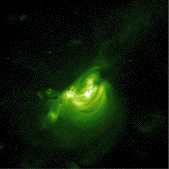 |
TRACE observed one of the first substantial magnetic bipolar regions
of the new solar cycle 24 to appear in the southern hemisphere of the
Sun. As usual for solar minimum, the region was small and not very
bright, and did not cause any flare. In fact, it was so small that it
did not have a sunspot, and not even any of the much smaller magnetic
pores; so technically, we should not call it an 'active region.' The
(4.5MB QuickTime) movie
shows about 15 hours in the life of this active region on May 7,
2008. Note the dynamic behavior of the loops near the core: their
configuration and brightness is always changing. Courtesy Paolo Grigis
(SAO).  |
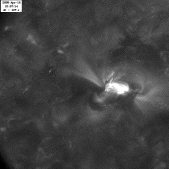 |
On 2008/04/16, TRACE observed a small active region and its surrounding
quiet Sun. this (1.2 MB) MPEG
movie shows a 75 min. interval (from 10:00 UT to 11:15 UT) of
the evolution of the corona. Notice how the corona north of the active
region darkens, possibly because the field reconnects and the plasma
on it either expands or changes in temperature. To the left of the
active region, a small eruption occurs as a much smaller bipole (an "ephemeral
region") emerges from below. The two events happen at the same time,
and one wonders about cause and consequence. Courtesy of Kathy
Reeves (SAO).
 |
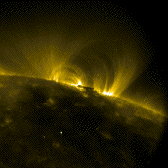 |
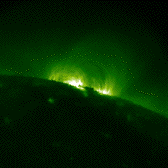
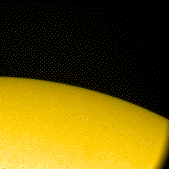
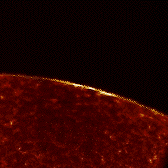
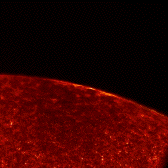
Active Region 10988 still shows up in the coronal images, even though it has rotated behind the solar limb in these images taken on 2008/04/07 around 11:20 UT (rotated by 90 degrees counterclockwise, and trimmed to 800x800 pixels). In front of it is a small filament, that absorbs the EUV radiation in the (yellow) 171Å image and in the (green) 195Å image. As expected, nothing shows up in the (bright yellow) visible light and (red) 1550Å and 1600Å images. Images courtesy Dawn Myers (GSFC).
|
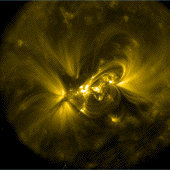 |
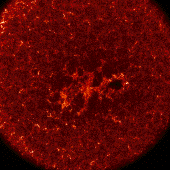
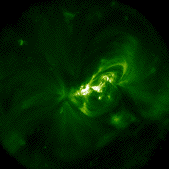
These images of Active Region 10988 in the 171Å, 1600Å, and 195Å passbands of TRACE were taken on 2008/03/31 at 7:05, 7:17, and 7:18 UT, respectively. The (yellow) 171Å images shows a set of well-defined, relatively cool (1 MK) coronal loops arching over and around the active region. Over the central parts of the region the plasma is too hot to show up well in the 171Å EUV channel, and we see only their lower ends, the so-called transition region, forming a pattern known as 'moss'. The moss in the trailing (left) polarity shows an unusual pattern of 'bubbles', not commonly seen. We think this is because the density of magnetic concentrations is relatively low (compare the central, red, 1600Å image) and somehow because of the 92 sec. exposure time - the other images with exposure times below 55 sec. do not show the bubbles. This is intriguing enough to deserve further attention .... Courtesy Samaiyah Farid (SAO).
|
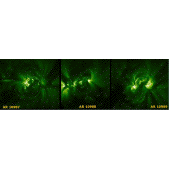 |
With the solar cycle well into its 11th year and a deep minimum,
the Sun still sports active regions, all part of the magnetic
collective of the 'old' (i.e., preceding) cycle, and therefore
all rather close to the solar equator. This composite shows three
successive regions that populated the Sun briefly together in
an otherwise very quiet period: AR 10987 observed
on 03/27/2008 at 02:10:17 UT;
AR 10988 on 03/30/2008 at 12:30:30; and
AR 10989 on 03/28/2008 at 14:08:49, all in the TRACE 171Å passband.
Image courtesy of Antonia Savcheva (SAO).
|
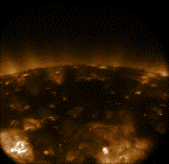 |
This images (rotated by 180 degrees) of the solar south pole (covered
by an extended coronal hole during the cycle minimum phase), was taken
by TRACE in its 171Å passband on 2008/03/17 at 05:38:47 UT.
It summarizes a couple of the current questions
on the origin of 'polar plumes'. It is easy to see the plumes generated by the
nice loops on the upper right corner, and we can see a stream of high
density plasma likely powered by magnetic
reconnection of the open field with the
emerging closed loop.
The best-defined plume on the image is the one left
of center, with a clearly defined structure, but no clear base structure.
Why do some plumes
have bright footpoints while others do not?
Courtesy Samaiyah Farid (SAO).
 |
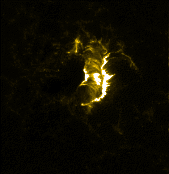 |

Sometimes solar flares occur successively in the same region and evolve in a very similar manner. Such flares are called "homologous flares". An example of two such homologous flares is shown in these TRACE 1600Å images. The image on the left shows AR 9236 at 2000/11/24 15:17 UT during an X2.3 flare that started at 14:51UT. The image on the righ was taken at 22:02 and shows the region during an X1.8 flare that started at 21:43UT. The similarity in flare pattern, evolution, and even peak brightness in soft X-rays shows that the earlier flares did not exhaust all the available energy, nor did it permanently deform the active-region's magnetic field. Note: a third X-class flare (X2.0) occurred earlier (at 04:55 UT)
at the same location. These flares were described in a study by
Takasaki et al. published in ApJ 613, 592 (2004).
|
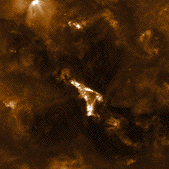 |
With the Sun near cycle minimum, there are very few substantial active
regions. But that does not mean that there is no activity: This
(2.7MB) QuickTime movie shows
a small active region (too small to even be given a NOAA designation number,
and without sunspots) obsered on 2008/02/12 from 00:43 UT to 18:51 UT.
Even this small regions exhibits multiple flaring (too small to be noticed in
the disk-integrated signal of the GOES monitoring spacecraft) in this
time interval. At least twice the corona around the region is disrupted
and a 'coronal dimming' occurs. The most notable one starts around 9:10 UT
towards the north. Image and movie courtesy of Aki Takeda (MSU).
 |
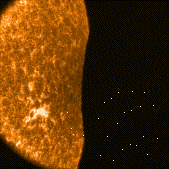 |
This 16MB movie, taken
by TRACE in its 1600&ARing; passband, shows one of the three lunar transits
observed on 2007/02/08. The movie (a 512 by 512 pixel cutout of the full
field of view) shows the Moon first obscuring part of the solar image
at 03:33 UT. Even though the Moon moves rather rapidly, causing some
blurring of the lunar edge druing the 0.9s exposures, some of the
mountains on the Moon can be seen in the image (see also the image to
the left, taken at 03:33:37 UT). Note that when the Moon has moved out
TRACE's field of view, the satellite's pointing drifts southward. This
is because the Moon continues to cover part of the solar limb; even though
this happens outside of the TRACE field of view, the guide telescope cannot
see the entire solar limb, causing the satellite to lose lock on its target.
As soon as the Moon moves off the Sun altogether, at 03:49 UT, TRACE
resumes its pointing to the pre-transit location.
 |
|
| Home | Mission | Instrument | Team | Operations | Results | Images | Movies | Education | Site Info. | |